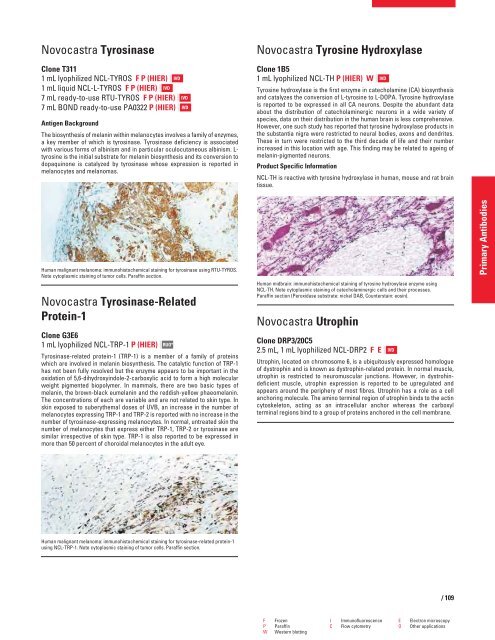QF0159 Marketing Release Record
QF0159 Marketing Release Record
QF0159 Marketing Release Record
Create successful ePaper yourself
Turn your PDF publications into a flip-book with our unique Google optimized e-Paper software.
Novocastra Tyrosinase<br />
Clone T311<br />
1 mL lyophilized NCL-TYROS F P (HIER)<br />
1 mL liquid NCL-L-TYROS F P (HIER)<br />
7 mL ready-to-use RTU-TYROS F P (HIER)<br />
7 mL BOND ready-to-use PA0322 P (HIER)<br />
Antigen Background<br />
The biosynthesis of melanin within melanocytes involves a family of enzymes,<br />
a key member of which is tyrosinase. Tyrosinase deficiency is associated<br />
with various forms of albinism and in particular oculocutaneous albinism. Ltyrosine<br />
is the initial substrate for melanin biosynthesis and its conversion to<br />
dopaquinone is catalyzed by tyrosinase whose expression is reported in<br />
melanocytes and melanomas.<br />
Human malignant melanoma: immunohistochemical staining for tyrosinase using RTU-TYROS.<br />
Note cytoplasmic staining of tumor cells. Paraffin section.<br />
Novocastra Tyrosinase-Related<br />
Protein-1<br />
Clone G3E6<br />
1 mL lyophilized NCL-TRP-1 P (HIER)<br />
Tyrosinase-related protein-1 (TRP-1) is a member of a family of proteins<br />
which are involved in melanin biosynthesis. The catalytic function of TRP-1<br />
has not been fully resolved but the enzyme appears to be important in the<br />
oxidation of 5,6-dihydroxyindole-2-carboxylic acid to form a high molecular<br />
weight pigmented biopolymer. In mammals, there are two basic types of<br />
melanin, the brown-black eumelanin and the reddish-yellow phaeomelanin.<br />
The concentrations of each are variable and are not related to skin type. In<br />
skin exposed to suberythemal doses of UVB, an increase in the number of<br />
melanocytes expressing TRP-1 and TRP-2 is reported with no increase in the<br />
number of tyrosinase-expressing melanocytes. In normal, untreated skin the<br />
number of melanocytes that express either TRP-1, TRP-2 or tyrosinase are<br />
similar irrespective of skin type. TRP-1 is also reported to be expressed in<br />
more than 50 percent of choroidal melanocytes in the adult eye.<br />
Human malignant melanoma: immunohistochemical staining for tyrosinase-related protein-1<br />
using NCL-TRP-1. Note cytoplasmic staining of tumor cells. Paraffin section.<br />
IVD<br />
RUO*<br />
IVD<br />
IVD<br />
IVD<br />
Novocastra Tyrosine Hydroxylase<br />
Clone 1B5<br />
1 mL lyophilized NCL-TH P (HIER) W<br />
Tyrosine hydroxylase is the first enzyme in catecholamine (CA) biosynthesis<br />
and catalyzes the conversion of L-tyrosine to L-DOPA. Tyrosine hydroxylase<br />
is reported to be expressed in all CA neurons. Despite the abundant data<br />
about the distribution of catecholaminergic neurons in a wide variety of<br />
species, data on their distribution in the human brain is less comprehensive.<br />
However, one such study has reported that tyrosine hydroxylase products in<br />
the substantia nigra were restricted to neural bodies, axons and dendrites.<br />
These in turn were restricted to the third decade of life and their number<br />
increased in this location with age. This finding may be related to ageing of<br />
melanin-pigmented neurons.<br />
Product Specific Information<br />
NCL-TH is reactive with tyrosine hydroxylase in human, mouse and rat brain<br />
tissue.<br />
Human midbrain: immunohistochemical staining of tyrosine hydroxylase enzyme using<br />
NCL-TH. Note cytoplasmic staining of catecholaminergic cells and their processes.<br />
Paraffin section (Peroxidase substrate: nickel DAB, Counterstain: eosin).<br />
Novocastra Utrophin<br />
Clone DRP3/20C5<br />
2.5 mL, 1 mL lyophilized NCL-DRP2 FE<br />
Utrophin, located on chromosome 6, is a ubiquitously expressed homologue<br />
of dystrophin and is known as dystrophin-related protein. In normal muscle,<br />
utrophin is restricted to neuromuscular junctions. However, in dystrohindeficient<br />
muscle, utrophin expression is reported to be upregulated and<br />
appears around the periphery of most fibres. Utrophin has a role as a cell<br />
anchoring molecule. The amino terminal region of utrophin binds to the actin<br />
cytoskeleton, acting as an intracellular anchor whereas the carboxyl<br />
terminal regions bind to a group of proteins anchored in the cell membrane.<br />
F Frozen I Immunofluorescence E Electron microscopy<br />
P Paraffin C Flow cytometry O Other applications<br />
W Western blotting<br />
IVD<br />
IVD<br />
/ 109<br />
Primary Antibodies
















